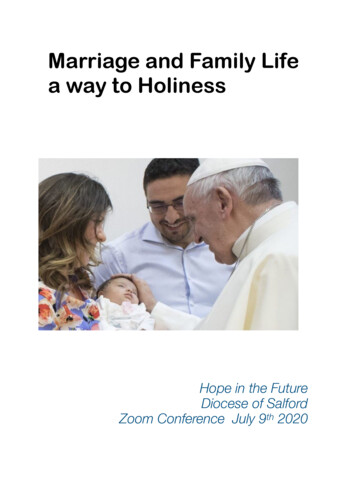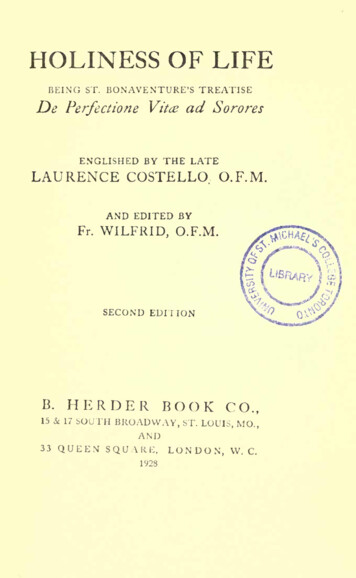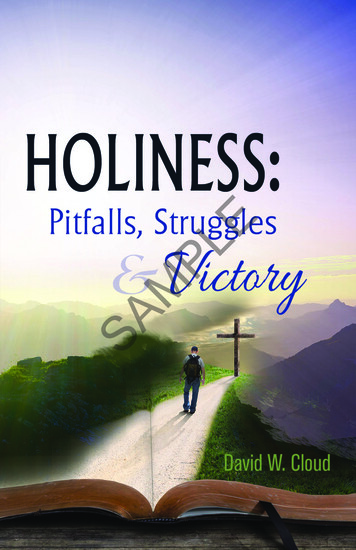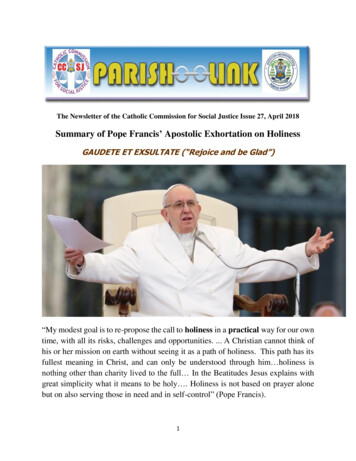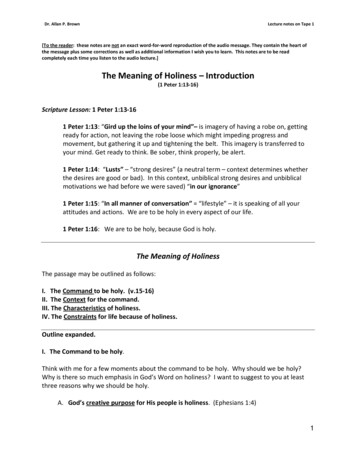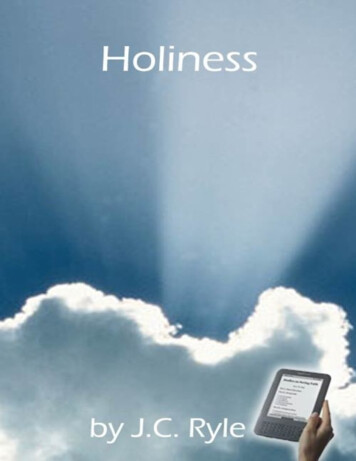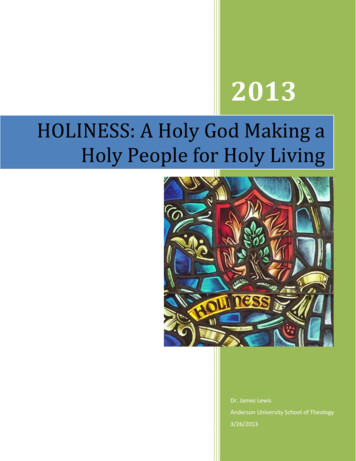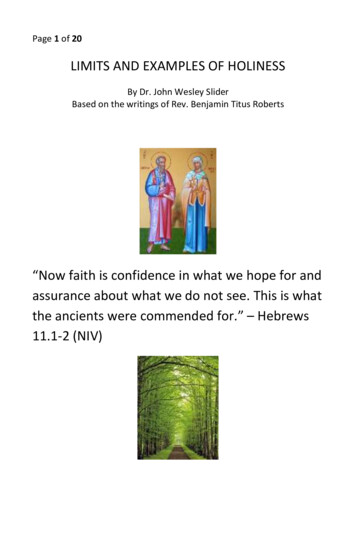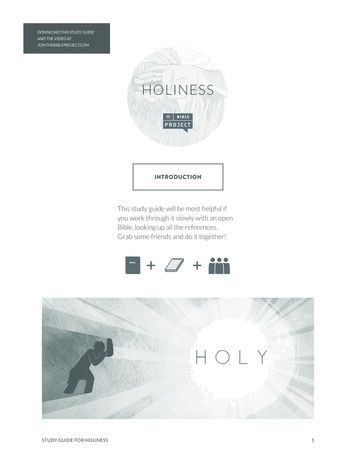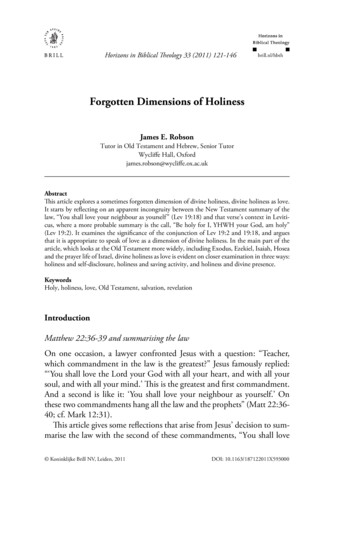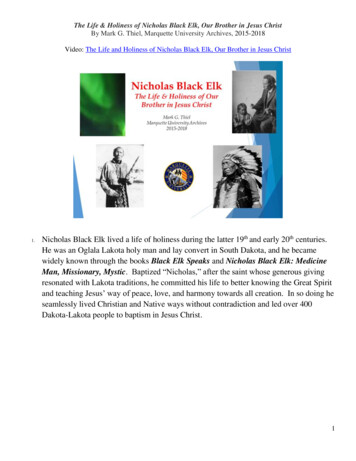
Transcription
The Life & Holiness of Nicholas Black Elk, Our Brother in Jesus ChristBy Mark G. Thiel, Marquette University Archives, 2015-2018Video: The Life and Holiness of Nicholas Black Elk, Our Brother in Jesus Christ1.Nicholas Black Elk lived a life of holiness during the latter 19th and early 20th centuries.He was an Oglala Lakota holy man and lay convert in South Dakota, and he becamewidely known through the books Black Elk Speaks and Nicholas Black Elk: MedicineMan, Missionary, Mystic. Baptized “Nicholas,” after the saint whose generous givingresonated with Lakota traditions, he committed his life to better knowing the Great Spiritand teaching Jesus’ way of peace, love, and harmony towards all creation. In so doing heseamlessly lived Christian and Native ways without contradiction and led over 400Dakota-Lakota people to baptism in Jesus Christ.1
2.So why canonize Nicholas Black Elk and why now? By baptism, all Christians are calledto become saints, and since its first days, the church has canonized outstanding Christiansshe identifies as intercessors of prayer and models of virtue. But north of Mexico, thebishops of the United States delayed initiating such efforts until 1884 when they feltsufficiently organized, which culminated in the canonization of first Saint Isaac Joguesand the Jesuit martyrs and Mohawk-Algonquin convert Saint Kateri Tekakwitha, all fromthe 17th century Great Lakes area. Meanwhile, more nominations and canonizations havefollowed with regularity, such as Saint Katharine Drexel, from the 20th century UnitedStates; Saint Juan Diego, from 16th century Mexico, Saints Antonio, Cristobal, andJuan, three Tlaxcala youth martyrs, also from 16th century Mexico; and the presumptivemartyrs Antonio Cuipa and companions, from 17th century Spanish Florida. Inspired bythese causes, many Christians believe now that Nicholas Black Elk should be declared asaint as well.2
3.According to his daughter, Lucy Looks, Heḣakasapa, or Black Elk, was born into BigRoad’s band in 1866 on the Little Powder River in Wyoming. In his family, he was thefourth generation named Black Elk after his father and grandfather who were prominentmedicine men. While growing up, he played boyhood games, hunted with his father, andlistened to the wisdom stories told by his elders. In so doing, he learned courage,bravery, and spiritual awareness in all things.3
4.As a boy, Black Elk developed a devotion and deep belief in divine power, and by agesix, his elders agreed that he had received a great vision from Wakan Tanka, the GreatSpirit. In it, he prayed atop Hinhan Kaga, or Black Elk Peak, which at 7,242 feet ofelevation, is the Black Hills’ highest point and the highest one in the United States east ofthe Rocky Mountains. He recalled, "I was standing on the highest mountain of them all,and round about beneath me was the whole hoop of the world. And while I stood there Isaw more than I can tell and I understood more than I saw; for I was seeing in a sacredmanner the shapes of all things in the spirit, and the shape of all shapes as they must livetogether like one being.” Four years later in Montana, on June 25-26, 1876, the Lakotaand their allies courageously faced the U.S. Army’s 7th Cavalry Regiment and achieved agreat victory in the Battle of the Little Bighorn. And although traumatized, young BlackElk supported his people to the extent possible. Fearing retaliation, several bands,including Big Road’s, fled into exile in western Canada where they endured starvation asthe buffalo herds declined. Meanwhile, because of his vision, some medicine men helpedBlack Elk to become a healer like his father and grandfather. Then after four years inCanada, Big Road’s Band began its return to South Dakota. Along the way, the peoplestopped, and while mounted on painted horses depicting the spirits of the four directions,Black Elk led them in the Horsetail Dance, which announced the start of his healingpractice.4
5.Big Road’s Band settled at Pine Ridge, one of the agencies of the Great Sioux IndianReservation, where Lakota life was changing rapidly. Black Elk remained strong in hisdevotion and respect to the Great Spirit, and he continually sought to learn more about hisways. In early 1885, he dictated a dire but hopeful letter to Iapi Oaye or Word Carrier, aProtestant Dakota language newspaper. In it he exclaimed, “ my relatives, those of youwho read the book [the Bible] it is necessary to have the people follow the lawsclosely. Life on earth is very near [the end] I believe ” And with 176 Lakota people –primarily grass dancers and mission schoolboys – Black Elk signed a letter supportingPope Leo XIII to declare the Mohawk virgin, Kateri Tekakawitha, a saint in heaven.Based at Standing Rock Agency, it was one of 27 such letters signed by Native NorthAmericans after the U.S. bishops had nominated her in December of 1884, and Lakotapeople responded resoundingly with a disproportionate share of the 906 total signatures.Quite likely, Father Francis Craft, shown here in clerical dress and dance regalia,encouraged this strong response. He was a Kateri devotee of some Mohawk ancestrywho immersed himself in Lakota culture while serving as an itinerant pastor reaching outto the Lakota people.5
6.Eager for adventure, Black Elk joined “Buffalo Bill” Cody’s Wild West show the nextyear where he visited Chicago, New York, and Montreal. The following year, the showvisited England. In London, because of his exceptional dancing ability, he was selectedas one of the few to dance for Queen Victoria’s private show honoring her 50thanniversary as queen. In London, a photographer took Black Elk’s picture while he, onthe left, and another dancer wore their regalia. To the north in Manchester, England,Black Elk and others rode streetcars. But the show moved on without them, which forcedhim to sharpen his English-speaking skills. Then alone, he visited Germany and livedwith a family in Paris, which further expanded his view of the world. He experiencedmore hospitality and saw Christian faith in action, and although he grew up believing allCrow Indians were horse thieves and untrustworthy, he learned to judge everyone fairlyand honestly as individuals, rather than as members of ethnic or racial groups, which inIapi Oaye he recorded, “ of the white man’s many customs, only his faith [their]beliefs about God’s will, and how they acted I wanted to understand. I traveled to onecity after another and there were many customs around God’s will.”6
7.By 1889, Black Elk was homesick in Paris, and he met Buffalo Bill who arranged hisreturn home to Pine Ridge. There he continued his spiritual quest by participating in theMessiah Movement or Ghost Dance, a religious revival with Lakota and Christian beliefs.After vigorous dancing, he had another vision. “I saw the holy tree full of leaves andblooming . . . Against the tree there was a man standing with arms held wide in front ofhim. I looked hard at him, and I could not tell what people he came from His hair waslong and hanging loose, and on the left side of his head he wore an eagle feather hisbody became very beautiful with all colors of light He spoke like singing: ‘My life issuch that all earthly things belong to me. Your father, The Great Sprit, has said this.You too must say this.’ Then he went out like a light in a wind ” and he noted the“ holes in the palms of his hands.” But the U.S. Cavalry ended it tragically atWounded Knee Creek on December 29, 1890. Just before it began, Father Craftattempted to persuade ghost dancers to turn back, for which Black Elk complementedhim as “ a very good man, and not like the other Wasichus.” Both were wounded andover 200 people were killed.7
8.Two years later, Black Elk married Katherine War Bonnet of the Pine Ridge Agencycommunity of Oglala, where they raised their family. Apparently, she was Catholic,because their three children – all sons including Ben – were so baptized. Katherine diedin 1903, and Black Elk continued his healing practice, while he, having conflictedthoughts, severe ulcers, and feelings of being drawn by the Great Spirit towards a newdirection. The next year, a Lakota family summoned him and Jesuit Father JosephLindebner to their home to minister to their dying son. While Black Elk prayed over theboy, the priest forcibly stopped him. Yet Black Elk deferred to him and his Christianprayer without protest and accepted his invitation to study the Catholic faith at the nearbyHoly Rosary Mission. After two weeks of intense study, Father Lindebner baptized him“Nicholas” on December 6th, the feast day of Saint Nicholas. Therefore, he took to heartthe legacy of his new patron saint – Saint Nicholas –known for his humility and charity,especially towards children and the poor, which resonated strongly with his commitmentto healing others. No longer did he sign his name as just Heḣakasapa or Black Elk;instead, now he signed it Nicholas or Nick Black Elk. Furthermore, medical treatmentssoon cured his ulcers permanently.8
9.Soon, Nick Black Elk married again, and his second wife, Anna Brings White, wasCatholic, too. She bore daughter Lucy the next year and two sons after that. Anna diedin 1942, and thereafter, Black Elk lived with his adult children and their families.9
10.Meanwhile, the Jesuits recognized Nick Black Elk’s enthusiasm and excellent memoryfor Scripture and church teachings in Lakota. So, they appointed him as a catechist orteacher of Christian faith where he campaigned for Christ in many camps andcommunities. At first, he served from Our Lady of the Sioux Church at Oglala above,and by 1907, he served most years from Saint Agnes at Manderson. In 1911, he attendeda statewide Catholic Sioux Congress at Holy Rosary where he and fellow catechists worethree-piece suits donated to the mission. But instead of wearing shoes, Black Elk worefully beaded moccasins. By then, he had ended his healing practice, because he saw it ascontradicting prayer to the Great Spirit as the Triune God of the Creator Father, his sonJesus Christ, and the Holy Spirit. Likewise, he repudiated the aspects of violence in hisgreat vision. Soon, other Lakota people who knew him as a healer followed him to Jesus.10
11.Nonetheless, Nicholas Black Elk continued his overall involvement in traditional Lakotaways. Now in his 40s, he still danced actively as shown in this 1908 lineup at a rodeo inInterior, South Dakota, just north of the reservation. While most dancers wore popularchief’s regalia, again Black Elk stood apart and wore the traditional warrior’s regalia withthe porcupine hair roach headdress and eagle feather crow belt.11
12.As a catechist, Nicholas Black Elk frequently taught the Bible with the Two Roads, acolorful teaching scroll, invented generations before. Here he’s teaching children with itat their Pine Ridge Reservation home during the 1920s.12
13.Read from bottom to top, the Two Roads presents a Biblical timeline along the centerfrom the Jewish Old Testament in black to Jesus’ New Testament in red andsupplemented with pictures of the world’s Creation in seven days, the Garden of Eden,Jesus’ life, and the Church’s founding to eternal judgement. The sides support the centerwith two parallel roads of contrasting conduct. The left presents a golden good way ofrighteousness with pictures of Noah’s Ark and the flood, the seven sacraments, the sevenvirtues of the Church, and the Communion of saints leading to a celestial Heaven; and theright presents a black bad way of difficulties with pictures of Cain’s sin leading fromEden to the Tower of Babel, the Protestant Reformers, and the Devil to a fiery Hell.13
14.Eye glasses were difficult to acquire. So only those with poor eyesight and a desire toread and write made the effort. Nicholas Black Elk was so motivated, as shown in SaintElizabeth’s Church, also in Oglala, in 1936 at age 70. Since he was past school age whenschools were first established at Pine Ridge, he made the extra effort and taught himselfto read and write using newspapers, the Bible, and other books in Lakota and English.14
15.Like other catechists, Nicholas Black Elk wrote pastoral letters about Christian living.They appeared in Šinasapa Wocekiye Taeyanpaha or The Catholic Voice, a Lakotalanguage newspaper distributed across the Northern Plains. From 1907 to 1916, he wrotemore than a dozen letters, and like Saint Paul, he called people to Jesus by relating hisexperiences to the stories in the Bible. Since he had made transatlantic crossings bysteamship, he used the sinking of the steamship Titanic as a metaphor to address greed inthe world in 1914. “ Some men constructed a very large and fast boat to make manymillions of dollars, so that one could cross the ocean in a few nights They said neverwould the boat sink. Yes, those rich men believed it, [but] they did not know what theywould come up against. So, one day they struck against something [and] the boat sank from blindness There is a grave sin here That is very troublesome, my Relatives.Desire to be close to our Savior. Desire to stay in our ship.”15
16.Because of his teaching abilities, the Bureau of Catholic Indian Missions, in Washington,D.C., funded Nicholas Black Elk to preach on several reservations. Starting in 1908, hedid so in Wyoming, Nebraska, and South Dakota with his close friend and partner, JesuitFather Henry Westropp on the left. Here he’s teaching on the Rosebud Reservation.16
17.From 1913 to 1916, Nicholas Black Elk and Father Westropp served on the YanktonReservation in South Dakota, which ended when he attended a statewide Catholic SiouxCongress there with these catechists and clergy.17
18.Later that summer, Nicholas Black Elk attended a Catholic Sioux Congress on the FortPeck Reservation in Montana. Shown next to him is Ojibwa Father Philip Gordon, agifted speaker from Wisconsin and chaplain at Haskell Institute in Kansas.18
19.Dur
1. Nicholas Black Elk lived a life of holiness during the latter 19th and early 20thcenturies. He was an Oglala Lakota holy man and lay convert in South Dakota, and he became widely known through the books Black Elk Speaksand Nicholas Black Elk: Medicine Man, Missionary, Mystic.

